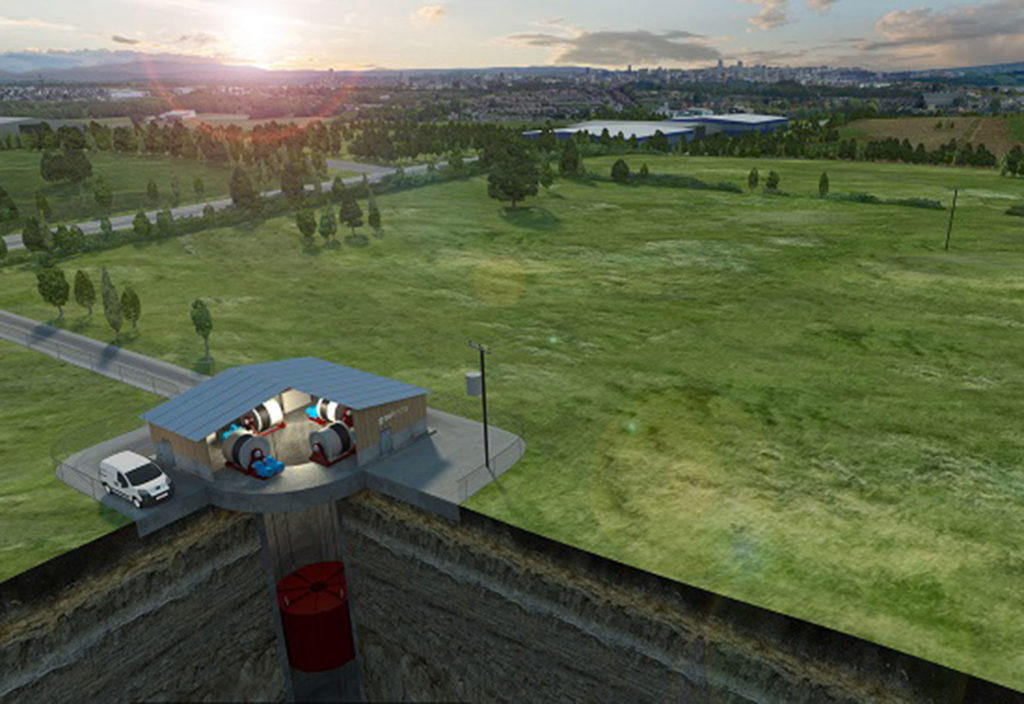Creative experiments with energy storage technology have been emerging recently. One development out of the UK could see cheap energy generated by dropping weights down old mine shafts.
Gravitricity, an energy startup based in Edinburgh, has drafted designs for a winch and hoist system that would drop 12,000-tonne weights down disused mine shafts. Similar to pumped hydro, the concept works by converting electrical energy to gravitational potential energy.
The concept sees electric winches hoisting weights to the top of the shaft when energy is plentiful. When there’s a dip in energy supply, the weights are dropped hundreds of metres down vertical shafts to generate electricity.
“It’s a simple case of ‘what goes up must come down’,” said Gravitricity Managing Director Charlie Blair.
“This weight can be released when required – in less than a second – and the winches become generators, producing either a large burst of electricity quickly, or releasing it more slowly depending on what is needed.”
If the energy comes from renewable sources, it could be a completely green form of energy storage and a way to repurpose abandoned infrastructure.
The concept was first developed by Gravitricity founder Peter Fraenkel, a UK chartered mechanical engineer. Fraenkel has a history of innovation – while serving as technical director at Marine Current Turbines, he developed and deployed the world’s first full-scale tidal energy turbine.
Battery of competition
According to Gravitricity, a full scale project would drop 24 weights to a depth of 800 m to produce enough electricity to power 63,000 homes for more than an hour.
An assessment from Imperial College London stated that the relatively low cost and potential 25-year lifespan of Gravitricity’s energy storage system could compete with lithium-ion batteries on price.
The report found electricity released by a typical 10 MW lithium-ion battery project would cost £283 (AU$532) per MWh over its lifetime. Meanwhile, projections for the Gravitricity project came in at £132 (AU$248) per MWh.
“The beauty of this is that this can be done multiple times a day for many years, without any loss of performance,” Blair said.
“This makes it very competitive against other forms of energy storage – including lithium-ion batteries.”
Gravitricity received a £650,000 (AU$1.2 million) grant from Innovate UK in 2018 to explore the idea further. The company plans to start building and deploy its first full-scale prototype in 2021 or 2022. The startup plans to eventually build models from 1 to 20 MW, and estimates each system will last up to 50 years.
The company is currently in discussions with mine shaft owners in the UK, Finland, Poland, the Czech Republic and South Africa.
Energy innovation
Other companies are exploring ways to generate electricity from less conventional sources while complementing the drive towards renewables.
Last year, Swiss startup Energy Vault unveiled a demonstration plant that stores energy by using an electric crane to stack concrete blocks. The amount of stored energy increases with the mass of the material lifted, so using a dense material like concrete rather than water means a greater amount of energy can be stored in a smaller volume.
When energy is abundant, the electricity can be used to stack concrete blocks. When supply is low, the blocks can be dropped back to Earth, running the crane’s motor backwards to release energy into the grid. The plant came together in nine months for the low price of AU$2.73 million.
Energy Vault received an injection of US$110 million (AU$161 million) in investment funds this past August. And earlier this year, in April, it was named by Fast Company as the winner of the World Changing Idea Award – Energy.
